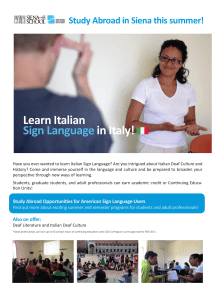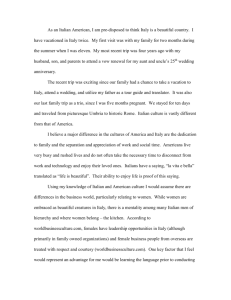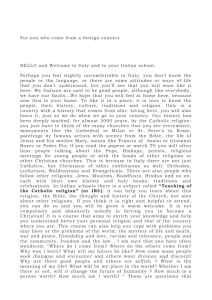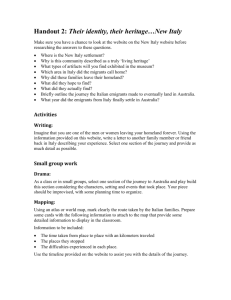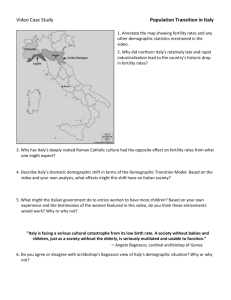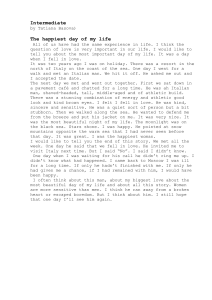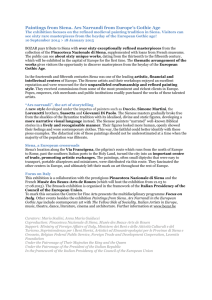Siena – Your Host City
advertisement
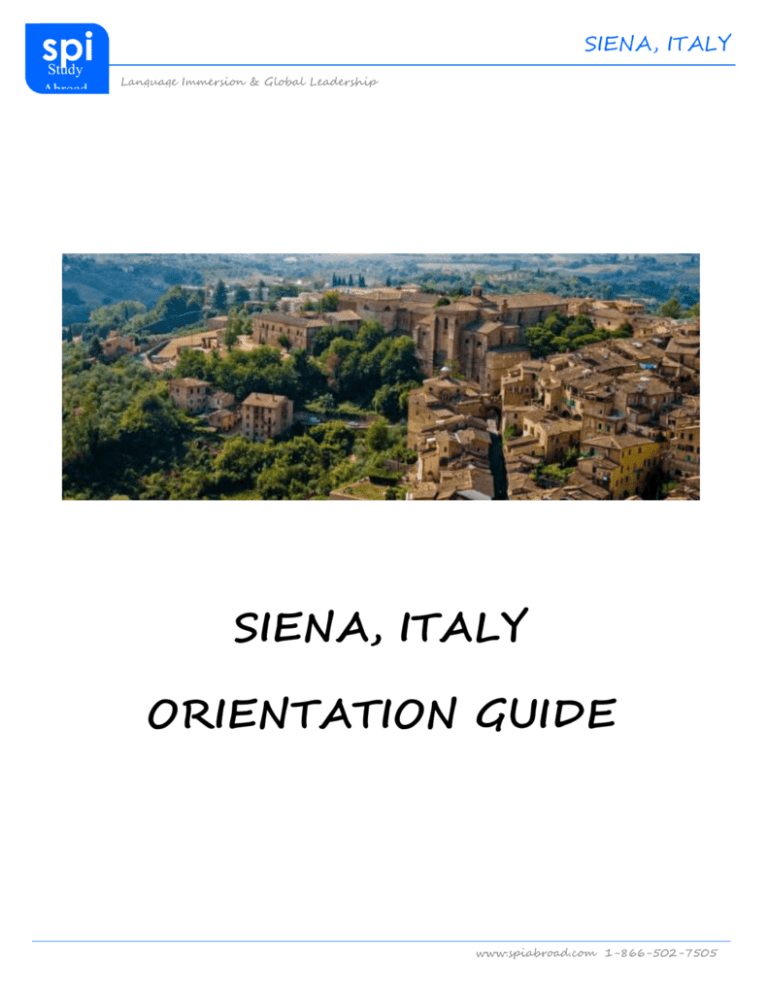
spi
Study
Abroad
SIENA, ITALY
Language Immersion & Global Leadership
Programs
SIENA, ITALY
ORIENTATION GUIDE
www.spiabroad.com 1-866-502-7505
spi
Study
Abroad
SIENA, ITALY
Language Immersion & Global Leadership
Programs
TABLE OF CONTENTS
Living in Italy
o
History
o
Italian Culture
o
Cultural Differences
o
Religion
o
Language
o
Map of Italy
o
Conversions & Measures
Siena – Your Host City
o
Orientation
School Info
o
School Information
o
Classes
o
Grading & Participation
Excursion Guide
o
Sorrento
o
Capri
o
Florence
o
Rome
Important Contacts Sheet
www.spiabroad.com 1-866-502-7505
spi
Study
Abroad
SIENA, ITALY
Language Immersion & Global Leadership
Programs
Living in Italy
History
Italy has significantly contributed to the cultural and social development of the entire
Mediterranean area, deeply influencing European culture as well. Important cultures and
civilizations have existed there since prehistoric times.
After Magna Graecia, the Etruscan civilization and especially the Roman Republic and
Empire that dominated this part of the world for many centuries came an Italy whose people
would make immeasurable contributions to the development of European philosophy,
science, and art during the Middle Ages and the Renaissance. Dominated by city-states for
much of the medieval and Renaissance period, the Italian peninsula was eventually unified
amidst much struggle in the 19th and 20th centuries.
The Italian province was privileged by Augustus and his heirs, with the construction, among
other public structures, of a dense mesh of roads. The Italian
economy flourished; agriculture, handicraft and industry
had a sensible growth, allowing the export of goods to the
other provinces. The Italian population grew as well. Three
census were ordered by Augustus, to record the presence of
male citizens in Italia. They were 4,063,00 in 28 BC,
4,233,00 in 8 BC, and 4,937,00 in AD 14. Including the
women and the children, the total population of Italia at the
beginning of the 1st century was around 1 million.
www.spiabroad.com 1-866-502-7505
spi
Study
Abroad
SIENA, ITALY
Language Immersion & Global Leadership
Programs
By the late Middle Ages, central and southern Italy, once the heartland of the Roman
Empire, was far poorer than the north. Rome was a city largely in ruins, and the Papal
States were a loosely administered region with little law and order. Italian trade routes that
covered the Mediterranean and beyond were major conduits of culture and knowledge. The
city-states of Italy expanded greatly during this period and grew in power to become de facto
fully independent of the Holy Roman Empire.
The Italian Renaissance began in Tuscany, centered in the city of
Florence and Siena. It then spread south, having an especially
significant impact on Rome, which was largely rebuilt by the
Renaissance popes. The Italian Renaissance peaked in the late 15th
century as foreign invasions plunged the region into turmoil.
Italian Culture
The culture of Italy can be found in the Roman ruins remaining in
much of the country, the precepts of the Roman Catholic Church, the spirit of the
Renaissance and the Enlightenment, and the architecture. It can also be tasted in Italy's food.
Roman Catholicism is the major religion: 85% of native-born citizens are nominally
Catholic; there are mature Protestant and Jewish communities and also a growing Muslim
immigrant community. All religious faiths are provided equal freedom before the law by the
constitution.
Italian art encompasses the visual arts in Italy from ancient times to the present. In Ancient
Rome, Italy was a centre for art and architecture. There were many Italian artists during the
Gothic and Medieval periods, and the arts flourished during the Italian Renaissance. Later
styles in Italy included Mannerism, Baroque and Rococo. Futurism developed in Italy in the
20th century. Florence is known all over Italy for its art museums.
Music has traditionally been one of the great cultural markers of what it means to be Italian
and holds an important position in society, in general, and even in politics. The music of
Italy ranges across a broad spectrum, from her renowned opera to modern experimental
classical music; and from the traditional music of the many ethnically diverse regions to a
vast body of popular music drawn from both native and imported sources. Historically,
musical developments in Italy in the Middle Ages and Renaissance helped create much of the
music that spread throughout Europe.
Italian cuisine is extremely varied - the country of Italy was only officially unified in 1861,
and its cuisines reflect the cultural variety of its regions and its diverse history (with
culinary influences from Greek, Roman, Gaul, Germanic, Goth, Norman, Lombard, Frank,
Turkish, Hebrew, Slavic, Arab and Chinese civilizations). Italian cuisine is imitated all over
www.spiabroad.com 1-866-502-7505
spi
Study
Abroad
SIENA, ITALY
Language Immersion & Global Leadership
the world.
Programs
To a certain extent, there is really no such thing as Italian cuisine in the way that one
usually understands national cuisines. Each area has its own specialties, primarily at the
regional level, but also even at the provincial level. Italian cuisine is not only highly
regionalized, but is very seasonal. The high priority placed on the use of fresh, seasonal
produce distinguishes the cuisine of Italy from the imitations available in most other
countries.
Cultural Differences
As mentioned before, there are a number of cultural differences between Italy and the US.
Here are a few tips to make your transition a little smoother:
The Italian People
Personal pride and individualism are highly valued.
Modesty is valued over assertiveness. Flaunting superiority, intelligence, or ability is
not appreciated.
Be patient. Nothing is done in a hurry. Italian trademarks are procrastination and
delay.
Meeting and Greeting
Men may embrace each other when meeting (friends and family
only).
Women may kiss each other on the cheek and embrace.
Expect to be interrupted when speaking.
Body Language
Never touch, hug or pat an Italian you do not know well,
unless a
friendly Italian touches you first.
Generally, Italians stand very close when talking. (As close as 12 inches!)
Italians speak a lot with their hands!
Dining and Entertainment
It is acceptable and common to be late by 15-30 minutes for social meetings.
Lunches/dinners are vital to establishing a relationship. It is a time to see if the
chemistry is correct and to develop trust.
No bread and butter plate is used. Bread is set directly on the table. Restaurants
generally charge for bread by the piece.
Italians don't waste food. It is better to decline food rather than leave it on your plate.
www.spiabroad.com 1-866-502-7505
spi
Study
Abroad
SIENA, ITALY
Language Immersion & Global Leadership
Programs
Dress
Appearance is extremely important to Italians. They dress elegantly, even for casual
occasions.
Dress conservatively. Provocative clothing makes you stand out in a negative way.
Shoes are the most important element of dress. Shabby looking shoes can ruin a very
nice outfit.
Gifts
When invited to someone's home, it is common to bring a small gift. Give pastries, cakes,
chocolates, flowers (red roses connote passion, yellow roses infidelity; give an odd number
of flowers, but never 13).
Italian Time:
Perhaps because of the benign climate and the long hours of sunshine in Italy, Italians tend
to get up later in the morning and stay out later at night than the rest of their European
neighbors. Shops and businesses are usually opened from 9-9:30am
to 1:30pm and from 4:30-5pm to 8-8:30pm though it has become
more and more common for businesses to stay open through the
afternoon hours.
Business establishments are usually closed for a day and half per
week, most often Saturday afternoon and Sunday, while many shops
close only on Sunday. In tourist areas and during the summer, business hours are often
expanded to 10-11pm with stores open 7 days a week.
Restaurant hours are varied, with the norm being from 1:30 to
3:30pm for lunch and from 8:30 to 11:30pm for dinner. In summer,
these hours are often expanded, with many establishments offering
continuous service and still other serving food into the small hours of
the night.
www.spiabroad.com 1-866-502-7505
spi
Study
Abroad
SIENA, ITALY
Language Immersion & Global Leadership
Programs
Religion:
Roman Catholicism is the predominant religion in Italy and is celebrated in the many
churches and cathedrals you will see and visit.
Regardless of your beliefs, experiencing a religious service in your country of study is an
important part of understanding the culture. Due to Italy’s history, its religious history is
solidified by its beautiful cathedrals that blanket the Italian countryside.
Lingua Italiano:
Italian is a Romance language spoken by about 63 million people, primarily in Italy and
Switzerland. Standard Italian was strongly influenced by the Tuscan dialect and is
somewhat intermediate between Italo-Dalmatian languages of the South and Gallo-Italian
languages of the North. Like many languages written using the Latin alphabet, Italian has
double consonants. However, double consonants are pronounced as long (geminated) in
Italian. As in most Romance languages (with the notable exception of French), stress is
distinctive. Of the Romance languages, Italian is generally considered to be the one most
closely resembling Latin in terms of vocabulary.
Map of Italy
www.spiabroad.com 1-866-502-7505
spi
Study
Abroad
SIENA, ITALY
Language Immersion & Global Leadership
Programs
Sorrento/Capri
Conversions:
www.spiabroad.com 1-866-502-7505
spi
Study
Abroad
SIENA, ITALY
Language Immersion & Global Leadership
Programs
Italy, along with the rest of Europe, uses the metric system. Measurements of clothes and shoe
sizes are also different.
multiply by
Weight
ounces to grams
28.35
grams to ounces
0.035
pounds to kilograms
0.45
kilograms to pounds
2.21
multiply by
Length & Distance
inches to centimeters
2.54
centimeters to inches
0.39
feet to meters
0.30
meters to feet
3.28
miles to kilometers
1.61
kilometers to miles
0.62
multiply by
Volume
gallons to liters
3.79
liters to gallons
26
Temperature
C° to F° multiply by 1.8 and add 32
F° to C° subtract 32 and divide by 1.8
Fahrenheit
104
0
14
32
41
50
68
77
86
95
0
5
10
20
25
30
35
212
Centigrade-17
-10
40
100
Clothing & Shoes
Womens’ Dresses
www.spiabroad.com 1-866-502-7505
spi
Study
Abroad
US:
SIENA, ITALY
Language Immersion & Global Leadership
Programs
Europe:
2
34
4
6
36
8
38
40
14.5
15
10
12
42
14
44
46
Mens’ Shirts
US:
14
Europe:
36
37
28
29
15.5
38
16
39
40
16.5
17
17.5
41
42
43
Mens’ Pants
US:
Europe:
71
73
30
31
32
76
79
81
7
7.5
8
33
34
84
35
36
86
89
9
9.5
91
Womens’ Shoes
US:
6
6.5
8.5
10
Europe:
35
35.5
36
37
37.5
38
39
39.5
40
Mens’ Shoes
US:
Europe:
7
40
7.5
40.5
8
41
8.5
42
9
42.5
9.5
43
10
44
10.5
44.5
11
45
SIENA – YOUR HOST CITY
Siena is a city of contrasts - from medieval treasures found within its historic walls to
modern shops and facilities located all around
the city center. Siena is built on three hills
surrounded by well-preserved walls in the
heart of Tuscany, about 43 miles south of
Florence. It is filled with superior examples of
Gothic architecture and has one of the world's
most unique public places in all of Italia: the
Piazza del Campo (shaped like a shell).
Siena was a proud, wealthy, and warlike
independent state during the Middle Ages,
until its final defeat by Florence. Medieval
Sienese art (painting, sculpture, architecture, etc.) is unique and of historical importance.
Sienese people are fiercely proud of their city and their sense of neighborhood and
community.
The summer months bring a wealth of festivities and events as this Tuscan city comes to life.
The Palio Festival, held twice a year in the summer, is all about neighborhood pride and
rivalry. Historic horse races take place on July 2 and August 16 each year - a long tradition
www.spiabroad.com 1-866-502-7505
spi
Study
Abroad
SIENA, ITALY
Language Immersion & Global Leadership
Programs
in Sienese culture. The festival constitutes the unbroken continuation of a medieval tradition
associated with religion, pageantry, trash-talking, and bragging.
Siena’s architecture is well preserved. It is a requirement that new buildings within the city
walls be built to look medieval, in order to maintain the
city's quaint character and beauty. It is a small city but has
a large student population which creates a studious
environment for learning Italian. It is also home to one of
the oldest universities in Europe, which ensures a vibrant
Italian student atmosphere throughout the academic year.
There are plenty of places to go and things to do in your free
time - from restaurants and pizzerias to cafes and shops;
from theaters and cinemas to museums and art galleries.
Siena has it all!
Siena's cathedral, the Duomo, begun in the twelfth century, is one of the great examples of
Italian Romanesque architecture. Its main facade was completed in 1380. It is unique among
Christian cathedrals in that its axis runs north-south.
This is because it was originally intended to be the largest
cathedral in existence, with a north-south transept and
an east-west aisle, as is usual. After the completion of the
transept and the building of the east wall (which still
exists and may be climbed by the public via an internal
staircase) the money ran out and the rest of the cathedral
was abandoned.
Inside is the famous Gothic octagonal pulpit by Nicola
Pisano (1266-1268) supported on lions, and the
labyrinth inlaid in the flooring, traversed by penitents on their knees. Within the Sacristy
are some perfectly preserved renaissance frescos by Ghirlandaio, and beneath the Duomo in
the baptistry is the marvelous baptismal font with bas-reliefs by Donatello, Lorenzo
Ghiberti, Jacopo della Quercia and other 15th century sculptors. The Museo dell'Opera del
Duomo contains Duccio's famous Maestà (1308-1311) and various other works by Sienese
masters. More Sienese paintings are to be found in the Pinacoteca.
The shell-shaped Piazza del Campo, the town square, which houses the Palazzo Pubblico
and the Torre del Mangia, is another architectural treasure, and is famous for hosting the
Palio horse race. The Palazzo Pubblico, itself a great work of architecture, houses yet
another important art museum. Included within the museum is Ambrogio Lorenzetti's series
of frescos on the good government and the results of good and bad government and also some
of the finest frescoes of Simone Martini and Pietro Lorenzetti.
www.spiabroad.com 1-866-502-7505
spi
Study
Abroad
SIENA, ITALY
Language Immersion & Global Leadership
Programs
On the Piazza Salimbeni is the Palazzo Salimbeni, a notable building and also the
medieval headquarters of Monte dei Paschi di Siena, one of the oldest banks in continuous
existence and a major player in the Sienese economy. Housed in the beautiful Gothic Palazzo
Chigi on Via di Citt is the Accademia Musicale Chigiana, Siena's conservatory of music.
The Medicean Fortress houses the Enoteca Italiana and the Siena Jazz School, with courses
and concerts all the year long and a major festival during the International Siena Jazz
Master classes. Over two weeks more than 30 concerts and jam sessions are held in the two
major town squares, on the terrace in front of the Enoteca, in the gardens
of the Contrade clubs, and in many historical towns and villages of the
Siena province. Siena is also home of Sessione Senese per la Musica e l'Arte
(SSMA), a summer music program for musicians.
Few geographical areas in the world can boast the variety of environment
that surrounds Siena. To the north, we have the richness of the Chianti
landscape, woven with vines and olive trees throughout the hills. Here
also are beautiful towns like San Gimignano and Monteriggioni with old
walls, winding streets and incredible views. South of Siena, the Arbia valley leads to the
hilltop town of Montalcino, home to the famous Brunello wine. And the area La Crete
stretches out, amazing visitors with its harsh rock formations and unique landscape. As you
head west toward the coast, you can visit captivating coastline towns like Castiglione della
Pescaia, and nature reserves like the area called Maremma. With such natural beauty
within easy reach by car or public transport, Siena is a good place to base yourself for a
Tuscan experience. The Chianti area, between Florence and Siena, is one of the most
beautiful countrysides in Italy and a famous wine production area.
PALIO FESTIVAL
Palio is a race which lasts less than 2 minutes is the subject of debate and competition all
year round. It is the greatest traditional festival in Siena!
Siena is divided into seventeen contrade, or areas of the city. The Sienese people belong first
to a contrada and then to the city. Each contrada competes against one another in the Palio,
and rivalry and competition are an integral part of the preceding months before the event.
Ten contrade are selected for each race, each contrada is assigned a horse, and the horses
compete in la corsa of Piazza del Campo while thousands of people come as spectators and
participants, transforming the main piazza into a teeming sea of people.
www.spiabroad.com 1-866-502-7505
spi
Study
Abroad
SIENA, ITALY
Language Immersion & Global Leadership
Programs
There are two Palio races each summer; one on the
2nd of July, and the second on the 16th of August.
The festivities start three days prior to each Palio,
although the anticipation is already evident weeks
before. During this time, there are banquets, parades,
blessing of the horses and celebrations of all kinds.
During these days, there are events such as the
assigning of the horses to the ten contrade, the first,
second, third and fourth trial, and the Prova
Generale, followed by the dinner of the Prova Generale for each contrada. Contrada colors
are worn by Sienese people, and music, singing and drumming can be heard on the streets at
all times of the day or night.
On the day of the Palio, spectators crowd into the piazza from noon on, willing to bear sun,
heat and sweat to witness this traditional event. The limited stadium seating around the edge
of the piazza is usually sold out eight months in advance.
The piazza is sealed off minutes before the Palio starts, and
eventually (after a few false starts), the horses are off, and it is
over before the dust settles. The winning contrada feasts and
celebrates for weeks afterwards, with banquets, replays and
much discussion, and the losing contrade can only hope that
with much preparation, plotting and luck, they will fare
better in the following race.
The Palio is a unique phenomenon, one that arouses much emotion, an event that the
Sienese people hold dear to themselves, and is a strong authentic tradition that is a once in a
lifetime experience to witness and enjoy.
www.spiabroad.com 1-866-502-7505
spi
Study
Abroad
SIENA, ITALY
Language Immersion & Global Leadership
Programs
The School: Dante Alighieri
ITALIAN CLASSES
The Dante Alighieri school you will attend is officially recognized by the Italian Ministry of
Education. Classes will be held Monday-Friday in the mornings for four hours a day
including breaks. Directors will inform you of exact class schedules upon arrival. It is
important to come prepared for class each morning and to take advantage of each intensive,
yet fun, class. The teaching method is unlike what is used in your U.S. classroom. All classes
- grammar, culture, and conversation are focused on improving your speaking and
understanding of the language. A placement test will be administered on the first day of
www.spiabroad.com 1-866-502-7505
spi
Study
Abroad
SIENA, ITALY
Language Immersion & Global Leadership
Programs
classes to place students in the appropriate class levels.
GRADING AND PARTICIPATION
Once classes have started, it is your responsibility to attend regularly and to take advantage
of all learning opportunities by participating actively. No matter how much you already
know, you will learn exponentially more Italian in your classes. These are college level
classes and you are expected to behave in an appropriate manner.
You will be evaluated on your participation and graded on exams. Grades will not be
reflected on your diploma but you must not miss more than one day of class to receive full
credit.
IMPORTANT
It is important to save all of your coursework, including exams. Most colleges and
universities require students to show the work they did while attending a foreign school.
Directions to School
Your host family will help guide you to school on
your first day.
Address:
Dante Alighieri Scuola d’Italiano
Via T. Pendola,
37 – 5310 Siena - Italy
Tel. +30577 49533
www.spiabroad.com 1-866-502-7505
spi
Study
Abroad
SIENA, ITALY
Language Immersion & Global Leadership
Programs
EXCURSION GUIDE
SORRENTO
Sorrento is a small city in Campania, Italy, with some 16,500 inhabitants. It is a popular
tourist destination due its picturesque and breathtaking scenery. Sorrento’s high cliffs
overlook the bay of Naples, as the key place of the Sorrentine Peninsula, and many
viewpoints in the city allow sight of Naples itself (visible across the bay) and also of Mount
Vesuvius. Sorrento's sea cliffs are impressive and its luxury hotels have attracted famous
personalities including Enrico Caruso and Luciano Pavarotti.
ORIGINS OF SORRENTO
The Roman name for Sorrento was Surrentum. Legends indicate a close connection between
Lipara and Surrentum, as though the latter had been a colony of the former; and even
through the Imperial period Surrentum remained largely Greek. The oldest ruins are Oscan,
dating from about 600 BC. Before the Roman supremacy,
Surrentum was one of the towns subject to Nuceria, and
shared its fortunes up to the Social War; it seems to have
joined in the revolt of 90 BC like Stabiae; and was reduced
to obedience in the following year, when it seems to have
received a colony.
The most important temples of Surrentum were those of
Athena and of the Sirens (the latter the only one in the
Greek world in historic times); the former gave its name to
the promontory. In antiquity Surrentum was famous for its wine, its fish, and its red
Campanian vases; the discovery of coins of Massilia, Gaul and the Balearic Islands here
indicates that extensive trade occurred.
The position of Surrentum was very secure, protected by deep gorges. The only exception to its
natural protection was 300 yards on the south-west where it was defended by walls, the line
of which is necessarily followed by those of the modern town. The arrangement of the modern
streets preserves that of the ancient town, and the disposition of the walled paths which
divide the plain to the east seems to date in like manner from Roman times. No ruins are
now preserved in the town itself, but there are many remains in the villa quarter to the east
of the town on the road to Stabiae, of which traces still exist, running much higher than the
modern road, across the mountain; the site of one of the largest (possibly belonging to the
Imperial house) is now occupied by the Hotel Victoria, under the terrace of which a small
www.spiabroad.com 1-866-502-7505
spi
Study
Abroad
SIENA, ITALY
Language Immersion & Global Leadership
Programs
theatre was found in 1855; an ancient rock-cut tunnel descends hence to the shore. Remains
of other villas may be seen, but the most important ruin is the reservoir of the (subterranean)
aqueducts just outside the town on the east, which had no less than twenty-seven chambers
each about 270 by 60 cm. Greek and Oscan tombs have also been found.
HISTORY
According to the Roman historian Diodorus Siculus, Sorrento was founded by Liparus, son of
Ausonus, who was king of the Ausoni and the son of Ulysses and Circe. The ancient city was
most likely connected to the Ausoni tribe, one of the most ancient ethnic groups in the area.
In the pre-Roman age Sorrento was influenced by theGreek civilization: this can be seen in
the presence of the Athenaion, a great sanctuary, also, according to the legend, founded by
Ulysses and originally devoted to the cult of the Sirens, whence Sorrento's name.
MIDDLE AGES AND MODERN ERA
Sorrento became an archbishopric around 420 AD. After the fall of the Western Roman
Empire, it was ruled by the Ostrogoths and then returned to the Eastern Empire. The
Lombards, who conquered much of southern Italy in second half of the 6th century, sieged it
in vain.
In the following centuries the authority of the far Byzantium empire faded, and Sorrento
became an autonomous duchy. It fought against the neighbor/rival Amalfi and the Saracens,
and in 1133 it was conquered by the Norman Roger II of Hauteville. From this point,
Sorrento's history followed that of the newly created Kingdom of Sicily.
On June 13, 1558 it was sacked by the Ottoman navy under the command of Dragut and his
lieutenant Piali, as part of the struggle between the Turks and Spain, which controlled the
southern half of Italy at that time. 2,000 captives were reportedly taken away. This struggle
was waged throughout the Mediterranean and lasted many decades. The attackers were not
"pirates"; some may have been mercenaries from North Africa. The campaigns were conducted
on direct orders of Sultan Suleiman. The attack led to the construction of a new line of walls.
The most striking event of the following century was the revolt against the Spanish
domination of 1648, led by Giovanni Grillo. In 1656 a plague struck the city. However,
Sorrento remained one of the most important centers of the southern Campania.
Sorrento entered into the Neapolitan Republic of 1799, but in vain. In the 19th century the
economy of the city improved markedly, favored by the development of agriculture, tourism
and trade. A route connecting Sorrento to Castellammare di Stabia was opened under the
reign of Ferdinand II (1830-1859).
In 1861 Sorrento was officially annexed to the new Kingdom of Italy. In the following years
it confirmed and increased its status of one of the most renowned tourist destinations of Italy,
www.spiabroad.com 1-866-502-7505
spi
Study
Abroad
SIENA, ITALY
Language Immersion & Global Leadership
Programs
a trend which continued into the 20th Century. Famous people who visited it include Lord
Byron, Keats, Goethe, Henrik Ibsen and Walter Scott.
CAPRI
Capri is an Italian island off the Sorrentine Peninsula, on
the south side of the Gulf of Naples. it has been a popular
vacation spot and resort since the time of the Roman
Republic.
The main features of the island are regularly portrayed on
postcards: the Marina Piccola (Small Harbor), the Belvedere
of Tragara, which is a high panoramic promenade lined
with villas, the limestone masses that stand out of the sea (the 'Faraglioni'), Anacapri, and
the Blue Grotto ('Grotta Azzurra'). Above everything are the ruins of the Imperial Roman
villas.
HISTORY
According to the Greek geographer Strabo, Capri was once part of the mainland. This has
been recently confirmed both by geological surveys and archaeological findings. The island
has been inhabited since very early times. Evidence of human settlement was discovered
during the Roman era; according to Suetonius, when the foundations for the villa of
Augustus were being excavated, giant bones and 'weapons of stone' were discovered. The
emperor ordered these to be displayed in the garden of his main residence, the Sea Palace,
and this is now considered one of the first displays of fossils. More modern excavations have
showed that human presence on the island can be dated back to the Neolithic and the
Bronze Ages.
In January 1806, French troops occupied the island. The British ousted the French troops in
May of the same year; Capri was turned into a
powerful naval base, but the building program
caused heavy damage to the archaeological sites.
Joachim Murat re-conquered Capri in 1808, and
the French remained there until the end of the
Napoleonic era (1815), when Capri was returned to
the Bourbon ruling house of Naples.
In the second half of the 19th century, Capri
www.spiabroad.com 1-866-502-7505
spi
Study
Abroad
SIENA, ITALY
Language Immersion & Global Leadership
Programs
became a popular resort for European artists, writers and other celebrities. John Singer
Sargent and Frank Hyde are among the prominent artists who stayed on the island around
the late 1870s.
The Villa San Michele was built around the turn of the 20th century by the Swedish
physician Axel Munthe, on the ruins of the Roman Emperor, Tiberius' villa, on the Island of
Capri. Its gardens have panoramic views of the city of Capri and its marina, the Sorrentine
Peninsula, and Mount Vesuvius. The villa and its grounds sit on a ledge at the top of the
Phoenician Steps, between Anacapri and Capri, at 327 meters above sea level. San Michele's
gardens are adorned with numerous relics and works of art dating back to ancient Egypt and
other periods of antiquity.
The Blue Grotto (Grotta Azzurra) is a noted sea cave on the coast of the island of Capri. The
grotto has a partially submerged opening into the sea, as do other grottoes into the island.
Roman emperors with villas on Capri reportedly used the Blue Grotto as a private bath. In
modern times, it has become a popular tourist attraction, with visitors touring it by boat.
Depending upon the tide and the size of the swells pounding the entrance to the grotto, the
guides will have passengers lie down while they pull the boat and sightseers into the grotto
with a chain permanently attached to the cave entrance.
Inside the grotto the sea seems to be lit from under water. It is a magnificent fluorescent blue
color, hence its name. This is due to another opening to the grotto, completely submerged, and
the limestone bottom. It allows in sunlight to truly light the water from below. The
underground passages leading to the grotto are partially sealed and supposedly once were
connected to catacombs of Roman tombs.
FLORENCE
A visit to Florence (Firenze) is a must for any art lover. UNESCO estimates that 60% of the
world’s most important artworks are in Italy, with over
half of them located in Florence. Situated in the
northwest of Italy, surrounded by the wine-growing hills
of Chianti, the city attracts rapture and frustration in
equal proportions. Few can dismiss the image of
Brunelleschi’s cathedral dome bursting through the
morning mist: a terracotta balloon hovering above the
medieval rooftops. But once the visitor drops down to
street level, the profusion of traffic and tourists can remove all sense of tranquility. It seems
every building holds a masterpiece, demanding attention and often gobbling up funds.
www.spiabroad.com 1-866-502-7505
spi
Study
Abroad
SIENA, ITALY
Language Immersion & Global Leadership
Programs
Often called the cradle of the Renaissance, Florence owes much of her wealth to the Middle
Ages. Banking became big business on the back of the city’s profitable wool trade and, in
1235, Florence minted the florin, the first gold coin to become
standard currency across Europe. Bankers commissioned some
of the finest art and architecture in the city. The names
Strozzi, Rucellai and Pitti can be found all over Florence, but
it was the Medici family (who led the city for over 300 years,
off and on) that nurtured the greatest flowering of Renaissance
art.
The paintings of Botticelli, the sculptures of Michelangelo and
the rusticated palaces of Michelozzo all flourished under
Medici rule. Then, as now, most of the action in Florence took
place between Piazza del Duomo and Piazza della Signoria,
the city’s civic heart. Here, in the historic center, Dante
(forefather of the Italian language) first glimpsed his muse,
Beatrice. Here, the Florentine Republic rose and fell. Florence
is a walking gallery of art, architecture and true Tuscan
culture.
PIAZZA DEL DUOMO (CATHEDRAL SQUARE): Brunelleschi’s gravity-defying dome
dominates the Florence skyline and defines the city. The dome that sits atop the city’s candycolored Duomo (cathedral) was an architectural breakthrough, since Brunelleschi invented
an entirely new way of counteracting the weight of the dome, thus building the largest selfsupporting dome since classical times. The cathedral (built under the proviso that it be the
largest house of worship in Christendom, a feat eventually claimed by St. Peter’s Cathedral
in Rome) took 15 years to complete. Its original facade was pulled down on the orders of
Ferdinand I in 1587. The Duomo remained faceless for nearly 300 years, until 1887.
Described by Ruskin as a Chinese puzzle, the lavish pink, white and green marble frontage
belies a cavernous interior that is surprisingly free from decoration. Once inside, most people
look heavenward, pausing to admire Giorgio Vasari’s recently restored frescoes in the cupola
before climbing the 463 steps for a spectacular view over the city. Tall, slender and straightbacked, the Campanile (bell tower) is the graceful sidekick to Brunelleschi’s stout Duomo.
Built according to Giotto’s designs in 1334, the Campanile was completed after its creator’s
death, by Andrea Pisano and Francesco Talenti. The tower is decorated with two garlands of
bas-reliefs, strung around its rose-tinted facade. Higher up, sculptures of the Prophets and
Sybils, carved by Donatello, look down upon the city below. The original pieces are now in
the Grande Museo della Opera del Duomo (Cathedral Museum). Visitors can climb the 414
steps of the Campanile for rewarding views over the piazza, which afford a closer inspection
www.spiabroad.com 1-866-502-7505
spi
Study
Abroad
SIENA, ITALY
Language Immersion & Global Leadership
Programs
of the Duomo and Brunelleschi’s rusty crown, once described by the architect Alberti as large
enough to shelter all the people of Tuscany in its shadow. The adjacent Baptistery completes
the trio. This provided the inspiration for both the Campanile and Duomo facades.
Originally believed to be a pagan temple, the octagonal building is the oldest in Florence. It
is famous for its gilded bronze doors, particularly those on the east side, dubbed the Gates of
Paradise. Executed by Lorenzo Ghiberti (with the greatest diligence and the greatest love) over
a period of 27 years, each of the bronze bas-reliefs tells a story from the Old Testament, with
astonishing realism and compassion. Nowadays, most are copies, the originals having been
moved to the Cathedral Museum for restoration and safekeeping. Ghiberti, the most selfsatisfied of artists, preserved his own balding image in the frame of the door, fourth in from
the left hand side.
GALLERIA DEGLI UFFIZI (UFFIZI GALLERY): The most important art collection in Italy and
one of the richest in the world is usually heralded by the burr of foreign tongues from the
queues of tourists that snake across the courtyard. Located in Vasari’s majestic Uffizi Palace,
the Uffizi Gallery houses the Medici art collection bequeathed to Florence in 1737, on the
condition that it never leaves the city. The impressive sum of Italian and in particular
Florentine art is arranged to illustrate how evolving techniques and ideas influenced the
artists. The huge collection is really too big for one to tackle at a single sitting, however,
visitors with limited time should ensure they take a peek at rooms seven to eighteen. These
include some of the city’s biggest draws Botticelli’s mythological masterpieces, The Birth of
Venus and Primavera (Spring) and Leonardo Da Vinci’s Annunciation. The first few rooms
concentrate on medieval art with a particular bent towards the Sienese school, exemplified
by Duccio, Martini and Giotto. The latter end of the gallery features work from the Umbrian
and Venetian schools, including Titian, Tintoretto and Raphael.
GALLERIA DELLA ACCADEMIA (ACCADEMIA GALLERY): While Florence offers a montage of
artwork, most people associate the city with just one masterpiece: Michelangelo’s David. The
huge statue occupies pride of place in the city’s Accademia Gallery, dwarfing the multitude
of chattering tourists who stand in awe before him. The statue was carved from a single block
of marble in 1502, when the artist was just 20 years old. Its exaggerated size and
musculature is a symbol of the new-born Republic that briefly cast out the Medici, the city’s
Goliath. Also in the gallery are Michelangelo’s unfinished Slaves, which stand captive in
blocks of marble, from which their forms seem to struggle to escape.
PONTE VECCHIO (VECCHIO BRIDGE): Even the dogs of war
could not bring themselves to destroy the Ponte Vecchio the
only bridge to survive the Nazi bombing of Florence during
World War II. Nowadays, the famous 14th-century bridge is
literally paved with gold (home to Florence’s gold and
www.spiabroad.com 1-866-502-7505
spi
Study
Abroad
SIENA, ITALY
Language Immersion & Global Leadership
Programs
silversmiths) and is a prime shopping trap for the city’s affluent tourists. It was Cosimo de
Medici who first created the mood for change, when he ordered the previous occupants (a
motley crew of butchers, accustomed to throwing their bloody leftovers into the River Arno) to
make room for a more genteel trade. High above the shops, a secret passageway known as the
Corrodoio Vasariano links the Uffizi Gallery to the Pitti Palace. Built by Vasari, it was
intended to shield the powerful Medici family from the Florentine riffraff, as they journeyed
from one palace to the other. Lined with portraits of the city’s greatest artists, the passage
reopened to the public in 1997.
ROME
FORUM ROMANUM AND PALATINE HILL
The heart of the ancient city embraces this vast archaeological site, dating from the period of
the kings to the emperors. Important buildings include the Curia, the temples of Vespasian,
Antoninus and Faustina, the House of the Vestals, the Basilica of Constantine and the arches
of Septimius Severus and Titus.
The archaeological area known as the Forum is only one of a
number of imperial fora, or meeting places, to be found in Rome.
In its midst lies a small column, the Umbilicus Urbis, the navel
of the city that marks the geographical center of the ancient urbis
as well as the Forum's heart. Corresponding to the modern piazza,
every aspect of daily business took place here - from religious
ceremonies to the vegetable market to the running of the
government of the Roman Empire. Political enemies brought
Caesar's body here to lie in state after his murder on the Ides of
March in 44 BC. Mark Antony delivered his famous speech in
Shakespeare's play beginning, “Friends, Romans, Countrymen...” from the Rostra platform. By
the end of the second century, the city fathers decided that Rome needed a more dignified
center. The food stalls were removed and law courts and business centers were added. As the
Empire expanded and the population boomed, the Forum became too small. New forums were
built to relieve congestion, but the Roman Forum remained the symbolic heart of the city.
With the fall of the empire and the rise of Christianity many marauders and rebels pillaged
buildings or used as quarries for ready building materials. By the 13th century the Forum
had entirely disappeared under meters of rubble and earth so that by the Renaissance the
area was known as the Campus Vaccinus or Cow Pasture with the tip of an occasional tall
column thrusting upward through the grass. Systematic excavation only began in the 19th
century. Today, it stands exposed, a multi-layered skeleton of 1000 years of civilization.
www.spiabroad.com 1-866-502-7505
spi
Study
Abroad
SIENA, ITALY
Language Immersion & Global Leadership
Programs
PALATINE HILL
Conveniently close to the Forum, the Palatine Hill became a fashionable residential area
during the Republic. Cicero, Mark Antony, the emperor Augustus and many other important
statesmen and aristocrats lived here. Established as the elite area of Rome, succeeding
emperors continued to live on the hill until the emperor Domitian
ordered a vast imperial residence to be constructed over the whole
site. The term Palatine became synonymous with the palace that
dominated the hilltop and thus the word palace was coined to
indicate any abode where a sovereign lived and ruled.
COLOSSEUM
Within the arched tiers of the Colosseum, audiences of 55,000 were
entertained by gladiators fighting to the death and by the mass
slaughter of wild animals. Begun by the Emperor Vespasian in 72 AD
on the site of an artificial lake in the grounds of the assassinated
Nero's Golden House, it was a constant reminder of the excesses of the
Empire. His successor, Titus, continued construction. What was formerly a tyrant's delight is
now the delight of the people, publicized by Vespasian's public relations campaign. The
slaughter of men and beasts, known as munus, had begun as a ritual intended to appease the
gods and train soldiers, but by the late Republic such spectacles had become mere
entertainment. At the inaugural games in 8 AD, 9,000 wild animals and hundreds of
gladiators were killed by men and common women. Both Pliny the Younger and Cicero,
writing a century apart, thought that the gladiators' fights exemplified the great Roman
virtues of discipline, self-sacrifice and fortitude, although Cicero did oppose the wild beast
hunts. Only Seneca attacked the spectacles outright. “It is pure murder,” he wrote.
PANTHEON
The majestic Pantheon has presided over its busy piazza for almost 2000 years. Its marble
columns and pediment, bronze doors, and soaring domed interior make it one of the most
harmonious and best-preserved monuments of antiquity. This circular temple dedicated to
All the Gods was rebuilt by the emperor Hadrian in 11AD and transformed into the
Christian church Sta. Maria and Martyres in the Middle Ages.
ORTI FARNESIANI
Originally the site of the Emperor Tiberius' palace, the Renaissance Farnese Gardens preserve
much of their original design. They were laid out in c.1550 by Vignola for Cardinal
Alessandro Farnese (1520-1589), nephew of Pope Paul III. Set with exotic plants, a maze,
two aviaries and a casino, the terraced pleasure gardens provided a cool retreat from the
Roman summer. Two flights of steps descend to the nymphaeum decorated with the Farnese
fleurs-de-lis.
www.spiabroad.com 1-866-502-7505
spi
Study
Abroad
SIENA, ITALY
Language Immersion & Global Leadership
Programs
BASILICA JULIA
Basilicas, inspired by the main hall of Greek royal palaces, were originally general meeting
places used for business or administration. Rectangular in plan
with a central nave, these large halls were the models for the
first Christian churches. The Basilica Julia, built in 54 BC as
part of the renovation of the Forum by Julius Caesar, was the
site of civil law courts. On the steps in front of the portico,
games, resembling draughts, snakes and ladders, can still be seen
incised into the marble to entertain those waiting.
HOUSE OF ROMULUS
Because the Iron Age inhabitants built their huts out of wood, only the circular foundations
dating to the mid-8th century remain as testimony to their presence. Until the end of the
4th century it was believed that the dwelling of Rome's founder Romulus was located here.
Nearby was the lupercal, the cave shrine of the she-wolf that suckled the abandoned twins
Romulus and Remus.
HOUSE OF LIVIA HOUSE OF AUGUSTUS
It is believed that the first wife of Augustus had this house, with its vestibules, courtyard and
three vaulted living rooms, connected to the imperial palace, the House Of Augustus. Built by
Domitian (81-96 AD), it was used by subsequent emperors as the headquarters of the empire.
The exterior walls, even as ruins, are so tall that modern archaeologists are still unsure how
they successfully installed the roof. The rooms around the house’s dining area are elaborately
decorated with frescoed wall paintings in the second Pompeian style, depicting a variety of
mythological scenes. In the House of Augustus the Triclinium, or dining room, hosted
imperial banquets between a set of twin oval fish ponds.
VATICAN CITY
The Vatican City State, sovereign and independent, is the survivor of the papal states that in
1850 comprised an area of some 17,000 square miles. During the struggle for Italian
unification, from 1860 to 1870, most of this area became part of Italy. By an Italian law of
May 13, 1871, the temporal power of the pope was abrogated, and the territory of the papacy
was confined to the Vatican and Lateran palaces and the villa of Castel Gandolfo. The popes
consistently refused to recognize this arrangement. The Lateran Treaty of February 11, 1929,
between the Vatican and the kingdom of Italy, established the autonomy of the Holy See.
The first session of Ecumenical Council Vatican II was opened by John XXIII on Oct. 11,
1962, to plan and set policies for the modernization of the Roman Catholic Church. Pope
Paul VI continued the council, presiding over the last three sessions. Vatican II, as it is called,
revolutionized some of the church's practices. Power was decentralized, giving bishops a
www.spiabroad.com 1-866-502-7505
spi
Study
Abroad
SIENA, ITALY
Language Immersion & Global Leadership
Programs
larger role, the liturgy was vernacularized, and laymen were given a larger part in church
affairs.
On Aug. 26, 1978, Cardinal Albino Luciani was chosen by the College of Cardinals to
succeed Paul VI, who had died of a heart attack on Aug. 6. The new pope took the name
John Paul I. Only 34 days after his election, John Paul I died of a heart attack, ending the
shortest reign in 373 years. On Oct. 16, Cardinal Karol Wojtyla, 58, was chosen pope and
took the name John Paul II. Pope John Paul II became the first Polish pope and the first
non-Italian pope since the 16th century.
On May 13, 1981, a Turkish terrorist shot the pope in St. Peter's Square, the first
assassination attempt against the pontiff in modern times. The pope later met and forgave
him. On June 3, 1985, the Vatican and Italy ratified a new church-state treaty, known as a
concordat, replacing the Lateran Treaty of 1929. The new accord affirmed the independence
of Vatican City but ended a number of privileges that the Catholic Church had in Italy,
including its status as the state religion.
On April 2, 2005, John Paul II died. He was the third-longest reigning pope (26 years). A
champion of the poor, he is credited by many with hastening the fall of Communism in
Poland and other eastern bloc countries. His vitality and charisma energized the world's 1
billion Catholics. His rule was characterized by conservatism regarding church doctrine,
particularly on issues such as birth control, women's roles in the church, and
homosexuality. The pope also remained circumspect about the U.S. church's sexual abuse
scandals in 2002. He was the Vatican's greatest ambassador, traveling to 120 countries. John
Paul II canonized 482 saints and beatified 1,338 people, which was believed to be more
than all his predecessors combined.
On April 19, cardinal Joseph Ratzinger was named the new pope. Pope Benedict XVI is
known as an accomplished scholar of theology and is considered an archconservative in his
religious views. He served as Pope John Paul II's closest associate and is expected to continue
the policy of a strong Rome. In Sept. 2006, Pope Benedict XVI apologized after angering
Muslims around the world by quoting medieval passages that referred to Islam as evil and
inhuman.
www.spiabroad.com 1-866-502-7505
spi
Study
Abroad
SIENA, ITALY
Language Immersion & Global Leadership
Programs
Important Contacts
On-Site Director Cell Phone Numbers (will be provided on arrival)
Head Director
_____________________________________
Asst. Director
_____________________________________
Asst. Director
_____________________________________
SPI Main Office (24 Hour)
From U.S.1-866-502-7505
From Italy 001-512-5027505
Dante Alighieri Scuola
dItaliano
www.spiabroad.com 1-866-502-7505
Director Luca Buonomi
spi
Study
Abroad
SIENA, ITALY
Language Immersion & Global Leadership
Programs
Emergency Numbers
General Emergency 112
U.S. Embassy Florence
(similar to our 911)
Lungarno Vespucci
Police 113
38 50123 FIRENZE
Ambulance 118
Tel. 3055 266 951
Fax 3055 215 550
Policia Municipal Office
0577 292550
Train Stations
Tourist Info Center
TRENO Main Station
Piazza Fratelli Rosselli
Piazza del Campo, 56Tel. 0577
Tel. 892021 HYPERLINK
280551
http://www.trenitalia.it/www.trenitalia.it
http://www.terresiena.it
infoaptsiena@terresiena.it
Public Transportation
Mon. – Sun 9.00am - 7.00pm
TRA-IN (Public Buses of Siena)
Hospitals
http://www.trainspa.it/en/home.html
10 Ride Tickets are cheaper
Azienda Ospedaliera Senese
Viale Bracci Mario, 16
Main Bus Station (long routes)
0577 585111
Piazza Antonio Gramsci
Sena Autlinee http://www.sena.it/
Azienda Ospedaliera Senese
SITA http://www.trainspa.it/
Il Campo, 1 (Located in the Center of
Town)
Taxis
0577 247586
Look for a taxi stand before trying to hail
Post Office
one down.
Piazza Matteotti Giacomo, 37
To call a cab: 0577 49222 OR 0577
289044
http:// www.comune.siena.it/taxi
www.spiabroad.com 1-866-502-7505
